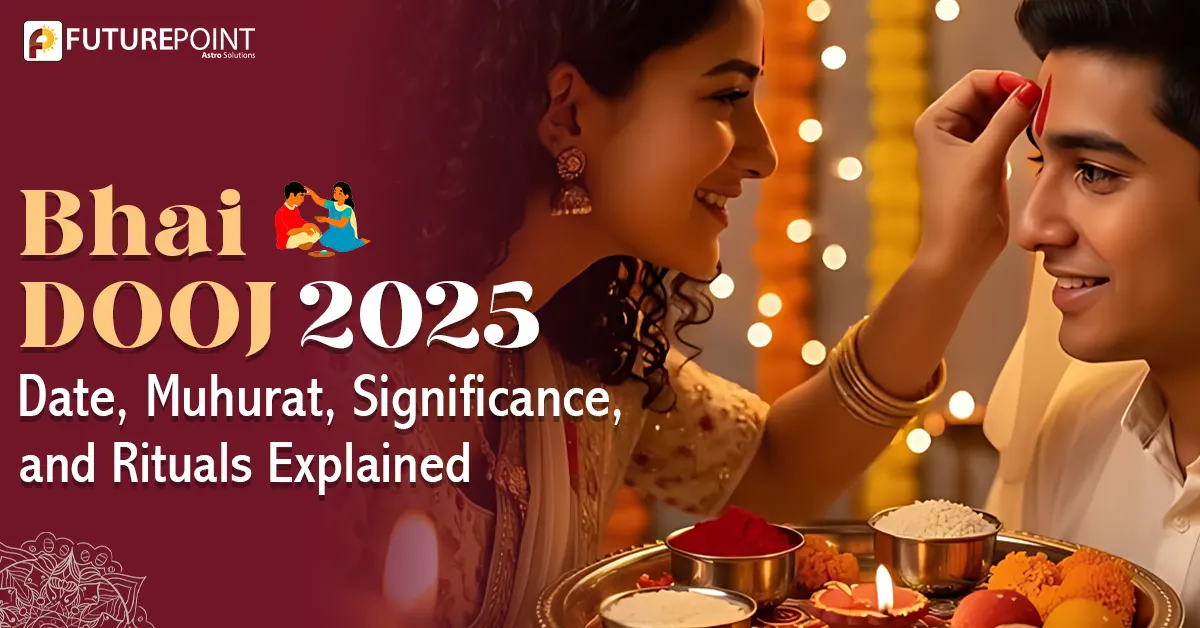Bhai Dooj 2025 : Date, Muhurat, Significance, and Rituals Explained
By: Future Point | 24-Sep-2025
Views : 25577
This festival has special significance. This festival is celebrated every year on the second day of Shukla Paksha of Kartik month. The festival of Bhai Dooj is a festival of trust and love between sister and brother. The name comes from “Bhai” meaning brother and “Dooj” which refers to the second day after the new Moon. This day is similar to Raksha Bandhan, but instead ritual for their brothers. Let us tell you that on this auspicious occasion, sister apply tilak to their brother and pray for his long life and happiness and prosperity. In such a situation the brother gives gifts and promises to protect their life. This festival is also known as Yam Dwitiya. This year the festival of Bhia Dooj will be celebrated on 3rd November.
When is Bhai Dooj 2025?
According to the Vedic Panchang, Kartik month Dwitiya Tithi will start on October 22 at 08:16 PM and Kartik Dwitiya Tithi will end on October 23 at 10:46 PM. According to Udayatithi, Bhai Dooj will be celebrated on November 3.
Bhaidooj shubh Muhurata 2025
According to the Panchang, there will be Saubhagya Yoga till 01:13 PM on 23rd October. After this Shobhan Yoga will start. Therefore the best time for worship on Bhai Dooj will be till 03:28 PM.
Importance of Bhai Dooj
There is a tradition of worshipping Lord Chitragupt on the day of Bhai Dooj. This festival strengthens the sacred relationship between brother and sister. Sisters do not eat anything before applying tilak to their brother. This period is called Bhai Dooj Vrat. It is a time for brothers to renew their promise to protect their sisters, while sisters pray for the long life and well-being of their brothers. It is believed that the brother who goes to his sister’s house and gets tilak on this day is free from the fear of untimely death. On the day of Bhai Dooj going to the sister’s house and eating food increases the age of the brother and he gets happiness and prosperity.
Legends behind Bhai Dooj
There are two main legends associated with Bhai Dooj:
1. Yamraj and Yami (Yamuna):
According to one legend, Yamraj the God of death, visited his sister yami (Yamuna) on this day. Yamuna welcomed him with a tilak, prayed for his well-being, and offered him sweets. In return, Yamraj gave her a gift and promised that any brother who receives tilak from his sister on Bhai Dooj will not fear death. Since then brothers and sisters have celebrated Bhai Dooj by following these rituals.
2. Krishna and Subhadra:
Another story related to Lord Krishna’s return after defeating the demon Narakasura, his sister Subhadra welcomed him with a tilak and prayed for his safety. Since then sisters have followed this tradition to ensure the protection of their brothers.
Bhai Dooj Rituals
The rituals for Bhai Dooj vary slightly across regions, but the basic customs are followed by many. Let’s overview of the key steps:
- Sister’s preparation: Sisters prepare a special thali (plate) that contains Vermillion (roli), rice, sweets, and a coconut. The thali also has a diya (lamp) which symbolizes the light of knowledge and happiness.
- Tilak ceremony: The sister applies a tilak (a sacred mark made of roli and rice) on her brother’s forehead. This act is believed to ward off evil and pray for her brother’s long life and prosperity.
- Aarti: The sister then performs an aarti around her brother. This act purifies the environment and removes the environment and removes negative energies from the brother’s life.
- Sharing sweets: After that Aarti, the sister offers sweets to her brother. The exchange of sweets signifies the love and sweetness in their relationship.
- Brother’s gift: In return, the brother gives gifts to his sister as a token of his love and appreciation. This gift is also a way of thanking her for the prayers and good wishes
- Special meals: The celebration often ends with a festive meal where the family gathers and both brothers and sisters enjoy the day together.
Regional Variations
- In Maharastra this festival is also known as Bhau beej where the rituals are slightly modified but still revolve around the tilak and prayers.
- In Bengal it is called Bhai Phota where sisters fast until the ritual is complete and chant mantra while applying the tilak.
Modern-Day Bhai Dooj
While the essence of Bhai Dooj remains the same, modern celebrations have adapted to changing times. Brothers and sisters who live far apart often celebrate through video calls or by sending gifts online. The love and bond remain intact, even if they can’t perform the rituals in person.
Conclusion
Bhai Dooj is more than just a ritual it’s a celebration of family ties. In a world where people often get busy with their daily lives, festivals like Bhai Dooj remind us of the importance of relationships, especially between siblings. It’s a time to express love, share happiness, and renew the bond that lasts a lifetime.